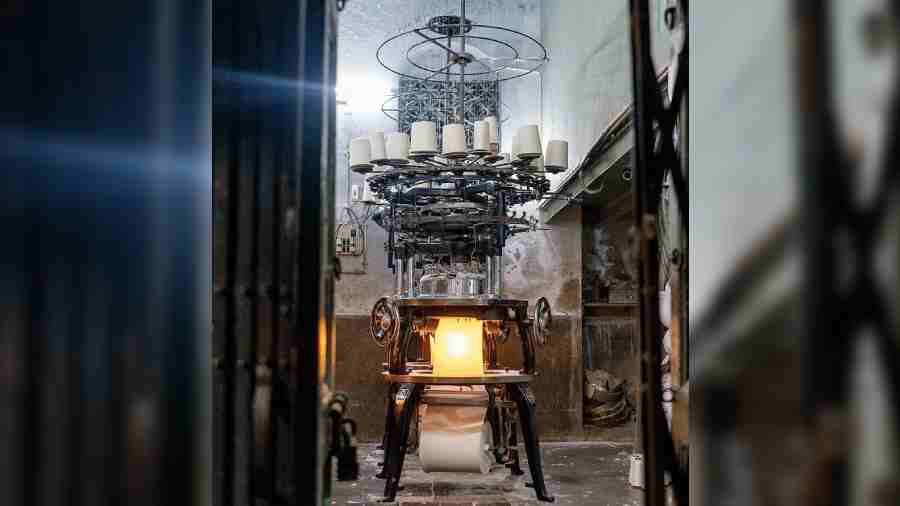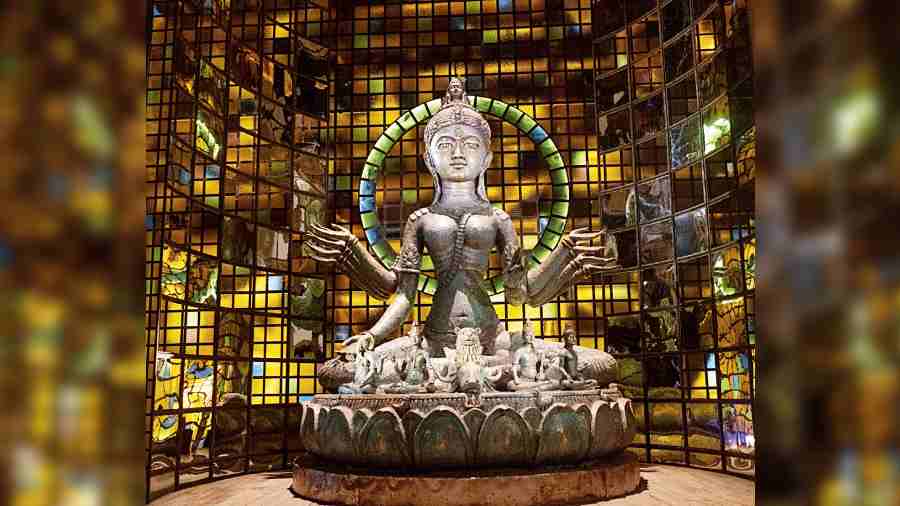Ten years ago, my husband accepted the post of director of the Alliance Francaise in Kolkata. My family and I spent five happy years here and fell in love with the city and its people, so when our next foreign posting in 2020 turned out to be Delhi, one of my first reactions was “Kolkata will be within reach!”
So here I am again, with my elder daughter, to drink up as much as we can of Durga Puja and make new discoveries.
On arrival, therefore, one of the first places we made for was Kumartuli. Soon enough, as dusk set in, we found ourselves pleasantly lost among adjacent alleys, and while keeping an eye out for the shadowy arm of a goddess to beckon us back on track, we rounded a corner and found light pouring out of an open doorway. There inside were strange machines (picture right), floodlit in the gathering darkness, with multiple bright spinning spools whose threads were drawn into the mechanism, to emerge on the other side as a tube of pure white light, or so it appeared. Once removed from the machine, the light faded, and they were revealed as white fabric, and were rolled and stacked away.
Upon finding ourselves once more reassuringly surrounded by goddesses in various degrees of composition and undress, we think we found the purpose of the wonderful machines, for we saw one of the same bundles in the arms of an idol-maker. He invited us to stroke the fabric — a fine, springy towelling. I mimed my question — a sari for a goddess? He responded by shaking his head, baring his teeth and growling. No doubt, it was clothing for the lions; their muscular clay bodies were fitted out in it, and idol makers snipped and folded it into the contours of their faces.
So do the marvellous spinning machines serve the sole purpose of clothing Durga’s lions in suits of soft towelling? Do they only appear this time of year, before disappearing back to the magical land from which they came, along with the lions themselves? Where else but Kolkata would you find yourself down some unremarkable alley, and stumble across such an example of the inventive, the nostalgic, the creative, the eccentric and the arcane?
Where else but Kolkata? And what better epitomises these qualities than the festival for which the lions are being suited — the deeply traditional yet riotously creative and extraordinary and open-hearted explosion of light and colour that is Durga Puja, which has at long last received the international recognition it deserves?
Mystery of bamboo scaffolds

The Shibmandir pandal in south Kolkata

Where the lions’ clothing is made
When I had first arrived in Kolkata a decade ago, we had barely left the airport before I was overtaken with curiosity about the bamboo scaffolding that seemed to be overrunning the whole town, winding along pavements, throwing arches over roads, and sometimes breaking free and erupting in spires and domes in all possible — and some impossible — spaces.
No explanations offered could provide a point of reference for me, as I had never heard of such things, let alone seen them. Moving tapestries of light? Short-term temples made of cloth and shiny paper thrown into the middle of the street, regardless of inevitable traffic chaos? As the date of the Puja approached and banners advertising everything from hair oil to timber wrapped themselves tightly round every pavement, those unimaginable structures hid behind layers of black plastic sheeting, like sweets waiting to be unwrapped, and the mystery increased.
And then it all began. The tapestries of lights were illuminated, the balloon sellers and chaat stands took their place, and the plastic sheeting was stripped away to reveal pandals decorated throughout with paper and tinsel, with brushes, with kites, with umbrellas, with plastic toys in acid pinks and greens, with paper cups and plastic cutlery, with every imaginable piece of flotsam deftly illuminated and transformed into something beautiful, unique and strange.
Drum beats and smoke filled the air, and there was the goddess, wide-eyed and beautiful, sometimes severe, sometimes gentle, sometimes outright eccentric, but always accessible, beckoning the whole city in. And the whole city came; a moving mass of humanity, passing together through these most extraordinary creations of light.
Being part of a moving mass of humanity is not for everybody of course. My husband’s position often allowed us VIP access, so I did not often sweat it out with everyone else, for which I am certainly grateful; however, those times when I did were undoubtedly memorable, where we seemed to collectively join bodies and move as one on our thousands of feet, glued together by sweat and proximity while traffic police prodded us forward — powerless to stop, and stepping in time with our arms holding smartphones and cameras above our heads in the hope that by some miracle we could capture the idol that we could barely see.
This experience, though vivid, is perhaps an acquired taste, and the mystery as to why such a massive and spectacular festival seems to have failed to engage the international community of travellers could perhaps be partly explained by this.
First look but minus life

Sovabazar Rajbari
Consequently, when we heard about the Unesco-partnered preview show this year, we immediately signed up, and we have spent that weekend, more than a week ahead of the actual ritualistic start, with Google Maps, seeking out the participating pandals. They were harder to find than usual because of the lack of balloon sellers and food stands, not to mention the crowds, and here was something surreal about walking down unassuming residential streets and finding empty fantastical structures built to accommodate thousands there.
No doubt, though, it was great to have time and space to absorb each creative flourish on pandal and idol, to have the concepts explained, and on occasion, to meet pandal artistes and designers. The fact that some pandals had not quite made it to the deadline, and were still full of artisans, working round the clock to get everything finished, was in itself interesting, and added to the experience.
I believe the pre-Puja show is a great idea, and it deserves to encourage tourists, who will sample the creativity without paying the price of the discomfort. I am very glad we were included.
However, it is not quite the experience that first led me to fall in love with Kolkata 10 years ago, and with the festival that epitomises it, as there is much more to love than the explosion of creativity. The paraphernalia of ritual: the incense, drums, garlands and incantations add mystery to the beauty, and the company of thousands of fellow travellers through the night, are the emotional heart of the festival, and without the masses, the sense that the Durga Puja is truly open-hearted, and everyone is unstintingly and unhesitatingly welcome is lost.
The more things change...

Gariahat Hindusthan Club
What is not lost is the diversity of theme. I have seen Durga represented in all sorts of ways, not just warrior-mother, but fish-wife, gauzy fairy, trapeze artist, and many more. I have seen her dressed in the blue-and-white uniform of the Sisters of the Missionaries of Charity, or in the posture of Buddha, and l have listened while the Muslim artist who designed the image in one pandal recited the story of her epic battle against the demon from the scroll that he had painted.
That is not to say that traditionalism is not very obviously part of Durga’s puja, and there are tens of thousands of idols being brought to life in Kumartuli today that must look exactly like their ancestors two centuries ago. My favourite flourish of this traditionalism are the charming toothy horse-lions with their row of manicured top-knot that sometimes accompany Durga; I have been told they came into being when the idol-makers could only imagine a mane on a horse, and thus conceived a lion as part horse, part tiger.
How lovely that this zoological oddity marches firmly on by Durga’s side to this day, indifferent to the many, impressively lifelike lion images that surround it, and absolutely accepted as one of the team. And how typical!

Laura Amalir is the author of Calcutta: Lens and Bylanes. Pictures are courtesy of the author
